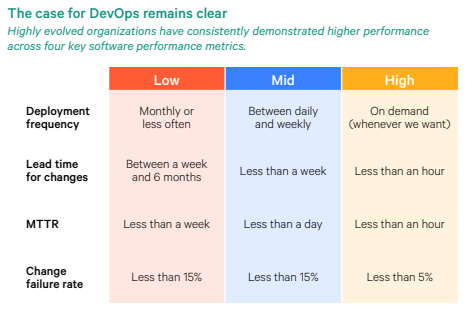The Future of DevOps Teams: Trends and Insights
Written on
Chapter 1: Understanding the Current State of DevOps
In the early days of DevOps, the emphasis was heavily placed on automation, focusing on streamlining the platform for rapid implementation and testing of changes. This automation of pipelines significantly enhanced the scalability, reliability, quality, and speed of our operations.
As we advance, however, DevOps has evolved beyond mere automation. Increasing automation allows teams to pivot and address fundamental strategic challenges, enabling structural enhancements and a stronger focus on delivering value to both teams and customers.
A common misconception is that cloud computing inherently equates to effective DevOps practices. While there is a clear connection, merely adopting cloud technologies does not guarantee proficiency in DevOps. The report reveals that simply increasing cloud usage does not automatically enhance DevOps capabilities.
The cloud provides the ability to provision and release capabilities dynamically through automation and self-service, steering organizations towards an Infrastructure as Code (IaC) methodology for rapid scaling. To fully leverage this, organizations must maintain control over their resources and adapt swiftly as needed.

Chapter 2: Key Metrics for Measuring DevOps Success
To assess the effectiveness of DevOps within organizations, we must establish measurable metrics.
The DevOps Research and Assessment (DORA) program, recognized for its extensive academic research, identifies four crucial metrics that characterize high-performing enterprises:
- Deployment Frequency: This measures how often code is deployed to production environments. While low-performing organizations may deploy monthly or less, high-performing companies can deploy thousands of times a day.
- Lead Time for Changes: This indicates the duration it takes for a team to develop a feature and deploy it successfully to production. Top performers can achieve this in less than a day, while low-level organizations might take months.
- Mean Time to Recovery (MTTR): This metric assesses how quickly a team can restore a service after a bug or incident affects the production environment. Leading companies can recover in under an hour, whereas less mature teams may take a week or longer.
- Change Failure Rate: This represents the percentage of changes that result in issues or degrade services. Elite teams maintain failure rates of less than 5%, while lower-performing organizations may exceed 15%.

Chapter 3: The Shifting Role of DevOps Teams
The report highlights a notable shift away from traditional DevOps teams within organizations. Increasingly, organizations are transitioning toward platform engineering, moving away from dedicated teams that focus solely on DevOps tools and practices. The primary objective of DevOps now is to manage platforms effectively for quick deployment and adaptation to changes.
This transition is not a cause for alarm. Instead of relying on specific DevOps teams, the industry is embracing DORA metrics at the core of projects. Developers, Operations, and Platform Engineers must collaborate to deliver services that are elastic, scalable, and responsive.
As one VP of Software Engineering remarked, "DevOps is not an organizational structure; it’s a mindset."
Chapter 4: Challenges in Adapting to DevOps
The Puppet report indicates that organizations at lower levels of maturity are struggling to adopt a DevOps mindset due to resistance to change. In contrast, more advanced organizations, despite having stakeholder buy-in, often face challenges in recruiting the right personnel to realize their vision. This has led to a significant increase in average salaries for DevOps roles, affecting the job market.
Chapter 5: The Future Landscape of DevOps
As DevOps organizations continue to evolve, they are adapting to foster a self-service model for developers. This entails creating efficient platforms that enable rapid delivery and seamless deployments.
There is a growing trend for enterprises to develop their own internal platforms to provide developers with user-friendly features and pipelines. The future of DevOps likely lies in eliminating the barriers between Operations and Developers, instead focusing on building an architecture that enhances development processes.
Establishing and maintaining a self-service platform requires more than just infrastructure; it must be tailored to align with business needs and delivery methods. Off-the-shelf solutions won’t suffice; organizations must invest in customizing these platforms to fit their technological landscape.
Thanks for reading! If you found this article helpful, please show your appreciation with a clap!
I frequently publish articles on DevOps topics exclusively on Medium. If you're interested in more insights, check out the following recommendations:
- Optimizing Docker Performance: 4 Essential Techniques
- Learning Containers: A Comprehensive Roadmap to Success
Consider supporting me and thousands of other writers by signing up for a Medium membership, which provides unlimited access to quality content. Your membership directly supports my work and the community!
The first video discusses the insights from the Accelerate State of DevOps Report, highlighting trends and essential metrics for success.
The second video succinctly summarizes the DORA State of DevOps Report, delivering key insights in just one minute.